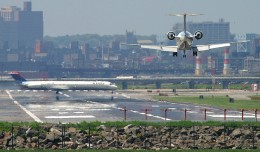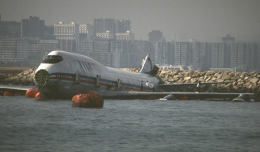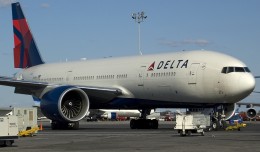2011: A US Army Chinook helicopter is shot down over Afghanistan, killing 38 people. Among them are 22 members of the Navy’s elite SEAL Team 6.
2005: Tuninter Flight 1153, an ATR 72 (TS-LBB) runs out of fuel and ditches into the Mediterranean Sea while flying from Bari, Italy to Djerba, Tunisia, killing 16 of the 39 people on board. Technicians had installed the wrong fuel fuel quantity indicator the night before, causing it to display far more fuel in the tanks than there actually was.
1997: Korean Air Flight 801, a 747-300, crashes into Nimitz Hill on the island of Guam, killing 228 of the 254 on board. The disaster is ultimately blamed on failures of the crew and Korean Air procedures. [NTSB animation]
1996: Japan’s Kawasaki OH-1 light attack helicopter makes its first test flight.
1990: The first US Air Force units are mobilized to the Middle East in response to Iraq’s invasion of Kuwait. Aircraft include F-15 fighters and B-52 bombers.
1969: The sonic boom from jets performing in an airshow shatters eight-blocks-worth of windows in downtown Kelowna, British Columbia.
1969: Do you even lift, bro? The biggest helicopter ever built, the Soviet Mil V-12 secures an unbeaten world lifting record for rotary-winged aircraft by carrying 40,205.5 kg (88,636 lb.) to a height of 2,255 m (7,400 ft.).
1966: Braniff Airways Flight 250, a BAC-111 flying from Omaha to Kansas City, crashes near Falls City, Nebraska, killing all 42 on board. The plane had flown directly into a violent thunderstorm, which damaged the flight control surfaces and wings, causing it to fall out of the sky.
1953: Ted Williams returns to the Red Sox after serving a tour of duty as a Marine airman in the Korean War.
1945: A US B-29 Superfortress named Enola Gay drops a 8900 pound atomic bomb called “Little Boy” onto Hiroshima, Japan. The first atomic bomb ever used had been developed through the ultra-secret Manhattan Project, which was originally headquartered in a building across the street from New York’s City Hall at 270 Broadway. The same building stands today, but its offices have been converted to condo apartments.
1945: America’s top World War II ace, Major Richard I. Bong (40 victories), is killed when his P-80 Shooting Star fighter crashes at Lockheed Air Terminal, Burbank, Calif.
1920: Stefan Bastyr, Polish aviation pioneer, is killed when his Fokker D.VII crashes while landing in Lviv.
1919: Captain Harry Butler makes the first flight over Australia’s St. Vincent Gulf, carrying mail between Adelaide and Minlaton.







